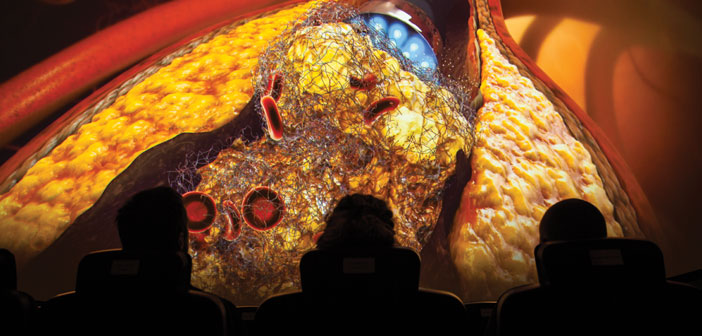An open-heart surgery shown on the dome in the planetarium … medical lectures for university students … these ideas, while at this time are “discussion only,” could be in the future for the Longway Planetarium in Flint.
The possibilities are endless, according to Buddy Stark, Manager, and with the upgraded technology that was added during the recent renovation, there are already some new and exciting educational opportunities which are geared toward K-12 students. “We have a selection of nine to twelve shows,” says Buddy. One such show is called To Space and Back, and explores the outgrowth of various technologies developed for the space program. “The show goes into great detail about the technology we have in our day-to-day lives that is due to the space program,” explains Buddy. To Space and Back also includes models of the human body including images inside arteries, MRI skull images, simulations of fat cells, and muscle tissue, and devices such as insulin pumps and pacemakers.
The public can experience virtual flights through the body to explore its workings, and see technology that has been adapted to improve medical science.
According to Todd Slisher, Director, students can also see a program in the portable dome called The Body Code, which helps teachers focused on biology and human anatomy. The public can experience virtual flights through the body to explore its workings, and see technology that has been adapted to improve medical science. “The new Longway Planetarium is a great tool to virtually explore various areas of science,” says Todd, “not only astronomy and space science, but also earth science and various other fields such as biology can be explored. Our programs focus on inspiring and educating the younger generation, so that they become engaged in these fields and grow up to be the future scientists, engineers and doctors that our region needs.”
What is in the future for Longway Planetarium? “We have some preliminary ideas for a show on genetics that we may develop in the future, but work on that has not yet begun,” Todd reports. He also says that K-12 and undergraduate educators might be able to use the facility to teach anatomy and virtually explore the human body and different body systems, like the circulatory and respiratory systems. There has been some discussion with area hospitals about using the planetarium for educational purposes.
Another concept that has been discussed, but is still in the infancy stage, is to create realistic models of human anatomy that can be manipulated in real time with just a keystroke, Buddy says. “This is something that our system is capable of, but would take a lot of modeling and programming work to implement.” The benefit of that type of program is that a medical lecture inside the dome could potentially include simulation of a surgical procedure. However, to develop a model to allow for programs such as this would be a very time-consuming and difficult task. “What we need to do is get some group or organization to back it and want to make it happen,” Todd says.
The planetarium staff includes a full-time modeler/programmer, Brian Wolff, who has been creating new models for use in innovative shows that range from space and earth science, to musical and art performances in collaboration with the Flint Institute of Music. “In the future,” Todd adds, “we hope to also tap the talents of area college students to create models for the show and the dome.”








